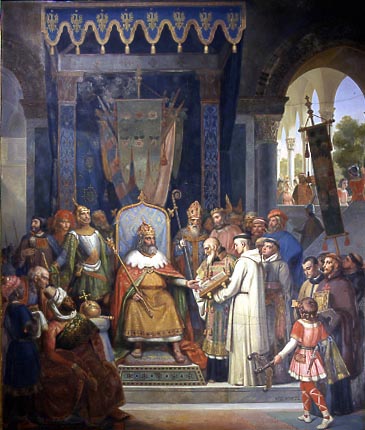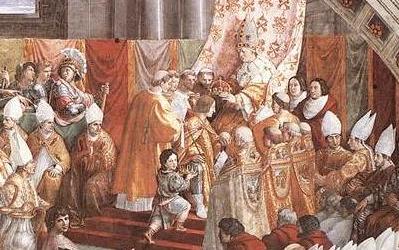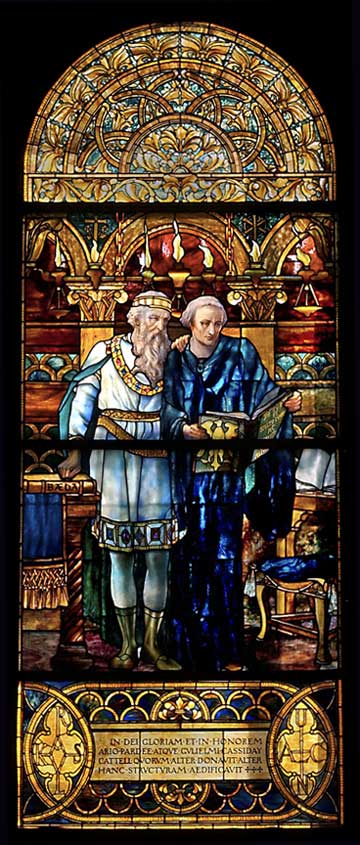Blessed Alcuin of York
An eminent educator, scholar, and theologian born about 735; died 19 May, 804.
He came of noble Northumbrian parentage, but the place of his birth is a matter of dispute. It was probably in or near York. While still a mere child, he entered the cathedral school founded at that place by Archbishop Egbert. His aptitude, and piety early attracted the attention of Aelbert, master of the school, as well as of the Archbishop, both of whom devoted special attention to his instruction. In company with his master, he made several visits to the continent while a youth, and when, in 767, Aelbert succeeded to the Archbishopric of York, the duty of directing the school naturally devolved upon Alcuin. During the fifteen years that followed, he devoted himself to the work of instruction at York, attracting numerous students and enriching the already valuable library.
While returning from Rome in March, 781, he met Charlemagne at Parma, and was induced by that prince, whom he greatly admired, to remove to France and take up residence at the royal court as “Master of the Palace School”.
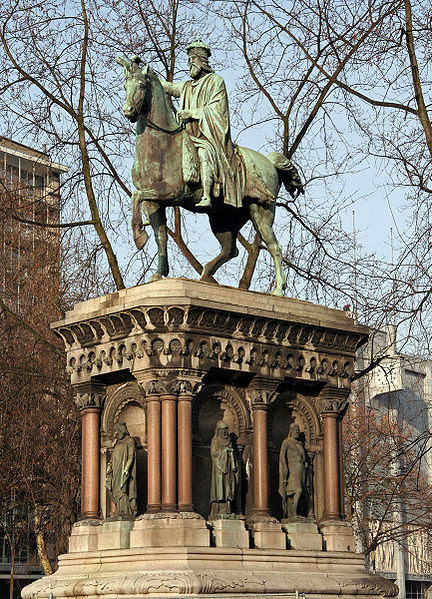
Alcuin met Charlemagne at Parma, and was induced by that prince, whom he greatly admired, to remove to France and take up residence at the royal court as "Master of the Palace School". Photo by Jacques Renier of Statue of Charlemagne in the center of Liège, Belgium.
The school was kept at Aachen most of the time, but was removed from place to place, according as the royal residence was changed. In 786 he returned to England, in connection, apparently, with important ecclesiastical affairs, and again in 790, on a mission from Charlemagne. Alcuin attended the Synod of Frankfort in 794, and took an important part in the framing of the decrees condemning Adoptionism as well as in the efforts made subsequently to effect the submission of the recalcitrant Spanish prelates. In 796, when past his sixtieth year, being anxious to withdraw from the world, he was appointed by Charlemagne Abbot of St. Martin’s at tours. Here, in his declining years, but with undiminished zeal, he set himself to build up a model monastic school, gathering books and drawing students, as before, at Aachen and York, from far and near. He died 19 May, 804.
Alcuin appears to have been only a deacon, his favorite appellation for himself in his letters being “Albinus, humilis Levita”. Some have thought, however, that he became a priest, at least during his later years. His unknown biographer, in describing this period, says of him, celebrabat omni die missarum solemnia (Jaffé, “Mon. Alcuin., Vita,” 30). In one of his last letters Alcuin acknowledged the gift of a casula, or chasuble, which he promises to use in missarum solemniis (Ep. 203). It is probable that he was a monk, and a member of the Benedictine Order, although this also has been disputed, some historians maintaining that he was simply a member of the secular clergy, even when he exercised the office of abbot at Tours.
Educator and scholar
Of his work as an educator and scholar it may be said, in a general way, that he had the largest share in the movement for the revival of learning which distinguished the age in which he lived, and which made possible the great intellectual renaissance of three centuries later. In him Anglo-Saxon scholarship attained to its widest influence, the rich intellectual inheritance left by Bede at Jarrow being taken up by Alcuin at York, and, through his subsequent labors on the Continent, becoming the permanent possession of civilized Europe. The influences surrounding Alcuin at York were made up chiefly of elements from two sources, Irish and Continental. From the sixth century onward Irishmen were busy founding schools as well as churches and monasteries all over Europe; and from Iona, according to Bede, Aidan and other Celtic missionaries bore the knowledge of the classics, along with the light of the Christian faith, into Northumbria. Both Aldhelm and Bede had Irish teachers. Celtic scholarship appears, however, to have entered only remotely and indirectly into Alcuin’s training. The strongly Roman cast which characterized the School of Canterbury, founded by Theodore and Hadrian, who were sent by the Pope to England in 669, was naturally reproduced in the School of Jarrow, and from this, in turn, in the School of York. The influence is discernible in Alcuin, on the religious side, in his devoted adhesion to Roman, as distinguished from particular local or national, traditions, as well as, in an intellectual way, in the fact that his knowledge of Greek, which was a favourite study with Irish scholars, appears to have been very slight.
An important feature of Alcuin’s educational work at York was the care and preservation, as well as the enlargement, of its precious library. Several times he journeyed through Europe for the purpose of copying and collecting books. Numerous pupils, too, gathered around him, from all parts of England and the continent. In his poem “On the Saints of the Church of York”, written, probably, before he took up his residence in France, he has left us a valuable description of the academic life at York, together with a list of the authors represented by its catalog of books. The course of studies embraced, in the words of Alcuin, “liberal studies and the holy word”, or the seven liberal arts comprising the trivium and the quadrivium, with the study of Scripture and the Fathers for those more advanced. A feature of the school that deserves mention was the organization of studies on the modern plan, the students being separated into classes, according to the subjects and divisions of subjects studied, with a special teacher for each class. But it was when he took charge of the Palace School that the abilities of Alcuin were most conspicuously shown.
In spite of the influence of York, learning in England was declining. The country was a prey to dissensions and civil wars, and Alcuin perceived in the growing power of Charlemagne and his eagerness for the development of learning an opportunity such as even York, with all its pre-eminence and scholastic advantages, could not afford. Nor was he disappointed. Charlemagne counted on education to complete the work of empire-building in which he was engaged, and his mind was busy with educational projects. A literary revival, in fact, had already begun. Scholars were drawn from Italy, Germany, and Ireland, and when Alcuin, in 782, transferred his allegiance to Charlemagne, he soon found surrounding him at Aachen, in addition to the youthful members of the nobility he was called upon to instruct, a band of older learners some of whom were ranked among the best scholars of the time.
Under his leadership the Palace School became what Charles had hoped to make it, the center of knowledge and culture for the whole kingdom, and indeed for the whole of Europe. Charlemagne himself, his queen, Luitgard, his sister Gisela, his three sons and two daughters became pupils of the school, an example which the rest of the nobility were not slow to imitate.
Alcuin’s supreme merit as an educator lay, however, not merely in the training up of a generation of educated men and women, but above all, in inspiring with his own enthusiasm for learning and teaching the talented youths who flocked to him from all sides. His educational writings, comprising the treatises “On Grammar”, “On Orthography”, “On Rhetoric and the Virtues”, “On Dialectics”, the “Disputation with Pepin”, and the astronomical treatise entitled “De Cursu et Saltu Lunae ac Bissexto“, afford an insight into the matter and methods of teaching employed in the Palace School and the schools of the time generally, but they are not remarkable either for originality or literary excellence. They are mostly compilations — generally in the form of dialogues drawn from the works of earlier scholars, and were probably intended to be used as textbooks by his own pupils.
Alcuin, like Bede, was a teacher rather than a thinker, a gatherer and a distributor rather than an originator of knowledge, and in this respect, it is plain to us now, the bent of his genius responded perfectly to the imperative intellectual need of the age, which was the preservation and the representation to the world of the treasures of knowledge inherited from the past, long buried out of sight by the successive tides of barbarian invasion. Disce ut doceas (learn in order to teach) was the motto of his life, and the supreme value he attached to the office of teaching is recognizable in his admonition to his disciples that the idle youth would never become a teacher in his old age (Qui non discit in pueritia, non docet in senectute, Ep. 27). Alcuin was eminently qualified to be the schoolmaster of his age. Although living in the world and occupied much with public affairs, he was a man of singular humility and sanctity of life. He had an unbounded enthusiasm for learning and a tireless zeal for the practical work of the class-room and library, and the young men of talent whom he drew in crowds around him from all parts of Europe went away inspired with something of his own passionate ardor for study. His warm-hearted and affectionate disposition made him universally beloved, and the ties that bound master and pupil often ripened into intimate friendship that lasted through life. Many of his letters that have been preserved were written to his former pupils, more than thirty being addressed to his tenderly loved disciple Arno, who became Archbishop of Salzburg. Before he died Alcuin had the satisfaction of seeing the young men whom he had trained engaged all over Europe in the work of teaching. “Wherever”, says Wattenbach, in speaking of the period that followed, “anything of literary activity is visible, there we can with certainty count on finding a pupil of Alcuin’s.” Many of his pupils came to occupy important positions in Church and State and lent their influence to the cause of learning, as the above-mentioned Arno, Archbishop of Salzburg; Theodulph, Bishop of Orléans; Eanbald, Archbishop of York; Adelhard, the cousin of Charles, who became Abbot of (New) Corbie, in Saxony; Aldrich, Abbot of Ferrières, and Fridugis, the successor of Alcuin at Tours. Among his pupils also was the celebrated Rabanus Maurus, the intellectual successor of Alcuin, who came to study under him for a time at Tours, and who subsequently in his school at Fulda, continued the work of Alcuin at Aachen and Tours.
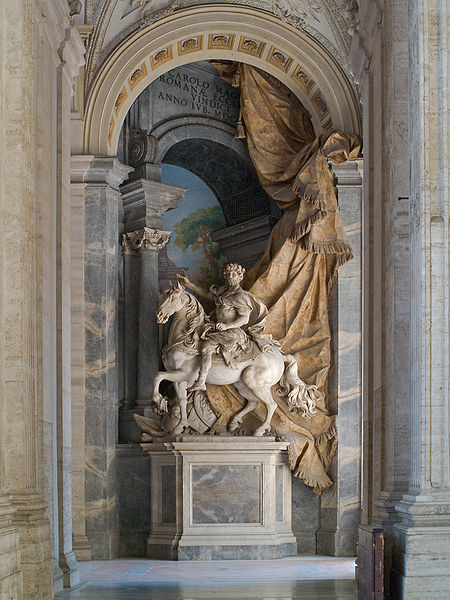
Monumental equestrian statue of Charlemagne, by Agostino Cornacchini (1725) — St. Peter's Basilica, Vatican. Photo by Myrabella.
The development of the Palace School, however, important as it was, was only a part of the broad educational plans of Charlemagne. For the diffusion of learning, other educational centers had to be established throughout the kingdom, and for this, in an age when education was so largely, under the control of the Church, it was essential that the clergy should be a body of educated men. With this object in view, a series of decrees or capitulars were issued in the name of the Emperor, which enjoined upon all clerics, secular as well as regular, under penalty of suspension and deprivation of office, the ability to read and write and the possession of the knowledge requisite for the intelligent performance of the duties of the clerical state. Reading-schools were to be established for the benefit of candidates for the priesthood, and bishops were required to examine their clergy from time to time, to ascertain the degree of their compliance with these educational laws. A scheme for universal elementary education was also projected. A capitular of the year 802 enjoined that “everyone should send his son to study letters, and that the child should remain at school with all diligence until he should become well instructed in learning” (West, 54). Following the decrees of the Council of Vaison, a primary school was to be established in every town and village to be taught by the priests gratuitously.
It is impossible to say to what extent Alcuin deserves credit for the organization of the vast educational system which was thus set up, comprising a central higher institution, the Palace School, a number of subordinate schools of the liberal arts scattered throughout the country, and schools for the common people in every city and village. His hand is nowhere visible in the series of legislative enactments referred to; but there can be no doubt that he had much to do with the instigation, if not with the framing, of these laws. “The voice”, Gaskoin aptly says, “is the voice of Charles, but the hand is the hand of Alcuin”.

“The voice is the voice of Charles, but the hand is the hand of Alcuin”. Statue of Alcuin at St. John the Divine, New York City. Photo by rbs10025.
It was with Alcuin, too, and his pupils that the responsibility rested for carrying out the legislation. True, the laws were only imperfectly carried into effect; the measures planned and partially put into practice for the enlightenment of the people did not meet with complete success; the movement for the revival and diffusion of learning throughout the Empire did not last. Yet much was accomplished that did endure. The accumulated wisdom of the past, which was in danger of perishing, was preserved, and when the greater and more permanent renaissance of learning came, several centuries later, when the light began to pierce through the storm-clouds of feudal strife and anarchy, the foundations laid in the eighth century were still there, ready to receive the weight of the higher learning which the scholars of the new revival should build up” (Gaskoin, 209). Alcuin’s poems range from brief, epigrammatic verses, addressed to his friends, or intended as inscriptions for books, churches, altars, etc., to lengthy metrical histories of biblical and ecclesiastical events. His verses seldom rise to the level of real poetry, and, like most of the work of the poets of the period, they often fail to conform to the rules for quantity, just as his prose, though simple and vigorous, shows here and there a seeming disregard for the accepted canons of syntax. His principal metrical work, the “Poem on the Saints of the Church at York”, consists of 1657 hexameter lines and is really a history of that Church.
Alcuin as a theologian
Alcuin’s work as a theologian may be classed as exegetical or biblical, moral, and dogmatic. Here again the characteristic that has been noted in his educational work is conspicuous it is that of conservation rather than originality. His nine Scriptural commentaries — on Genesis, The Psalms, The Song of Solomon, Ecclesiastes, Hebrew Names, St. John’s Gospel, the Epistles to Titus, Philemon, and the Hebrews, The Sayings of St. Paul, and the Apocalypse — consist mostly of sentences taken from the Fathers, the idea, apparently, being to collect into convenient form the observations on the more important Scriptural passages of the best commentators who had preceded him. A more important Biblical undertaking by Alcuin was the revision of the text of the Latin Vulgate. At the beginning of the ninth century, this version had displaced in France, as elsewhere throughout the Western Church, the Old Itala (Vetus Itala) and other Latin versions of the Bible; but the Vulgate, as it existed, showed many variants from the original of St. Jerome. Uniformity in the sacred text was in fact, unknown. Every church and monastery had its own accepted readings, and varying texts were often to be found in the Bibles used in the same house. Other scholars besides Alcuin were engaged in the task of endeavoring to remedy this condition. Theodulph of Orléans produced a revised text of the Vulgate which has survived in the “Codex Memmianus“. The original work of Alcuin has not come down to us, the carelessness of copyists and the extensive usage to which it attained having led to numberless, though for the most part unimportant variations from the standard he sought to fix. In his letters he simply mentions the fact that he is engaged, by the order of Charlemagne, “in emendatione Veteris Novique Testamenti” (Ep., 136). Four Bibles are shown by the dedicatory poems affixed to them to have been prepared by him, or under his direction at Tours, probably during the years 799-801. In the opinion of Berger the “Tours Bibles” all represent in a greater or less degree, notwithstanding their variations in detail, the original Alcuinian text (Hist. de la vulg., 242). Whatever the exact changes made by Alcuin in the Bible text may have been, the known temper of the man, no less than the limits of the scholarship of the age, makes it certain that these changes were not of a far-reaching kind. The idea being, however, to reproduce the genuine text of St. Jerome, so far as possible, and to correct the gross blunders which disfigured the Sacred writings, the Biblical work of Alcuin was, from this point of view, important. Of the three brief moral treatises Alcuin has left us, two, “De virtutibus et vitiis“, and “De animae ratione“, are largely abridgments of the writing of St. Augustine on the same subjects, while the third, “On the Confession of Sins”, is a concise exposition of the nature of confession, addressed to the monks of St. Martin of Tours. Closely allied to his moral writings in spirit and purpose are his sketches of the lives of St. Martin of Tours, St. Vedast, St. Riquier, and St. Willibrord, the last being a biography of considerable length.
It is upon his dogmatic writings that the fame of Alcuin as a theologian principally rests. Against the Adoptionist heresy he stood forth as the foremost champion of the Church. It is a proof of his power of penetration — a quality of mind which some historians appear to deny him altogether — that he so clearly perceived the essentially heretical attitude of Felix and Elipandus toward the Christological question, an attitude whose heterodoxy was shrouded perhaps even from their own eyes in the beginning, by the specious distinction between natural and adoptive sonship; and it was a worthy tribute to the range of his patristic scholarship when Felix, the chief intellectual defender of Adoptionism, after the disputation with Alcuin at Aachen, acknowledged the error of his position. The condemnation of the rising heresy by the Synod of Regensburg (Ratisbon), in 792, having failed to check its spread, another and a larger synod, composed of representatives of the Churches of France, Italy, Britain, and Galicia, was convened at Frankfort by the order of Charles, in 794.
Alcuin was present at this meeting and no doubt took a prominent part in the discussions and in the drawing up of the “Epistola Synodica“, although, with characteristic modesty, he furnishes no evidence of the fact in his letters. Following up the work of the Synod, he addressed to Felix, for whom he had formerly entertained high esteem, a touching letter of admonition and exhortation. After his transfer to Tours, in 796, he received from Felix a reply which showed that something more than friendly entreaty would be needed to stay the progress of the heresy. He had already drawn up a small treatise consisting mainly of patristic quotations, against the teaching of the heretics, under the title “Liber Albini contra haeresim Felicis“, and he now undertook a larger and more thorough discussion of the theological questions involved. This work, in seven books, “Libri VII adversus Felicem“, was a refutation of the position of the Adoptionists, rather than an exposition of Catholic doctrine, and hence followed the lines of their arguments, instead of a strictly logical order of development. Alcuin urged against the Adoptionists the universal testimony of the Fathers, the inconsistencies involved in the doctrine itself, its logical relation to Nestorianism, and the rationalistic spirit which was forever prompting to just such attempted human explanations of the unsearchable mysteries of faith. In the spring of 799 a disputation took place between Alcuin and Felix in the royal palace at Aachen, which ended by Felix acknowledging his errors and accepting the teachings of the Church. Felix subsequently paid a friendly visit to Alcuin at Tours. Having sought in vain to bring about the submission of Elipandus, Alcuin drew up another treatise entitled “Adversus Elipandum Libri IV“, entrusting it for circulation to the commissioners whom Charlemagne was sending to Spain. In 802 he sent to the emperor the last, and perhaps the most important, of his theological treatises, the “Libellus de Sancta Trinitate“, a work which is uncontroversial in form, although probably suggested to him during the discussions with the Adoptionists. The treatise contains a brief appendix entitled “De Trinitate ad Fridegisum quaestiones XXVIII“. The book is a compendium of Catholic doctrine concerning the Holy Trinity, St. Augustine’s treatise on the subject being kept steadily in view. It is uncertain to what extent Alcuin shared in the attitude of remonstrance assumed by the Frankish Church, at the instance of Charlemagne, towards the badly translated and ill understood decrees of the second Council of Nicaea, held in 787. The style of the “Libri Carolini” which condemn, in the name of the King, the decrees of the Council, favours the assumption that Alcuin had at least no direct part in the composition of the work.
Alcuin as a liturgist
Besides his justly merited fame as an educator and a theologian, Alcuin has the honor of having been the principle agent in the great work of liturgical reform accomplished by the authority of Charlemagne.
At the accession of Charles the Gallican rite prevailed in France, but it was so modified by local customs and traditions as to constitute a serious obstacle to complete ecclesiastical unity. It was the purpose of the King to substitute the Roman rite in place of the Gallican, or at least to bring about such a revision of the latter as to make it substantially one with the Roman. The strong leaning of Alcuin towards the traditions of the Roman Church, combined with his conservative character and the universal authority of his name, qualified him for the accomplishment of a change which the royal authority in itself was powerless to effect. The first of Alcuin’s liturgical works appears to have been a Homiliary, or collection of sermons in Latin for the use of priests. The Homiliary which was printed under his name in the fifteenth century was by a different hand, although it is probable, its Dom Morin contends, that a recently discovered manuscript of the twelfth century contains the genuine Alcuinian sermons. Another liturgical work of Alcuin consists of a collection of the Epistles to be read on Sundays and holy-days throughout the year, and bears the name, “Comes ab Albino ex Caroli imp. praecepto emendatus“. As, previous to his time, the portions of Scripture to be read at Mass were often merely indicated on the margins of the Bibles used, the “Comes” commended itself by its convenience, and as he followed Roman usage here also, the result was another advance in the way of conformity to the Roman liturgy. The work of Alcuin which had the greatest and most lasting influence in this direction, however, was the Sacramentary, or Missal which he compiled, using the Gregorian Sacramentary as a basis, and to this adding a supplement of other liturgical sources. Prescribed as the official Mass-book for the Frankish Church, Alcuin’s Missal soon came to be commonly used throughout Europe and was largely instrumental in bringing about uniformity in respect to the liturgy of the Mass in the whole Western Church. Other liturgical productions of Alcuin were a collection of votive Masses, drawn up for the monks of Fulda, a treatise called “De psalmorum usu“, a breviary for laymen, and a brief explanation of the ceremonies of Baptism.
A complete edition of Alcuin’s works, with the exception of some of his Epistles, is to be found in Migne, comprising volumes 100-101 of the “Patrologia Latina“. The text of the Migne edition was first published by Froben, Abbot of St. Emmeran, at Ratisbon, in 1777, a previous and less complete edition having been published by Duchesne at Paris, in 1617. A critically accurate edition of the “Epistles” of Alcuin, together with his poem, “On the Saints of the Church at York”, his “Life of St. Willibrord and the “Life of Alcuin”, composed about 829, is found in the fourth volume of the “Bibliotheca Rerum Germanicarum“, under the title “Monumenta Alcuiniana” edited by Jaffé, Wattenbach, and Duemmler (Berlin, 1873). This edition contains 293 of Alcuin’s Epistles, against the 230 in Migne.
(from 1907 Catholic Encyclopedia)
